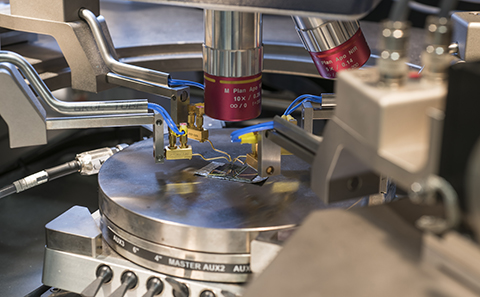Fifty students from over forty schools around the UK took part in a Computing and Microelectronics course at Southampton last week, organised by educational charity The Smallpeice Trust.
The five-day residential course enabled students from Years 11 and 12 to build and program a substantial autonomous robot that can compete against other robots to navigate its way around an arena and collect objects.
During the week, students learned about design, fabrication and testing of devices, circuits, microprocessors and systems; explored theories and practices in computing and electronic engineering; gained first-hand experience of university life, mingling with academics and students from Electronics and Computer Science (ECS) at the University of Southampton; had the opportunity to visit ECSâ nanofabrication cleanrooms and Tony Davies High Voltage Laboratory; and took part in engaging talks on computer vision, cyber security and robotics.
The course was sponsored by Arm and Farnell element14, and delivered by the Source Bots team in ECS, under the direction of Adriana Wilde, Teaching Fellow and Senior Tutor. Source Bots team member Anton Nikitin, a second year MEng Electronic Engineering student, kept a diary of the weekâs activity. Read about his experience below:
Another year, another robotics summer school! Over the week commencing the 31st July we welcomed 50 students from schools and colleges around the country for an action-packed week of robot hacking, programming, and engineering shenanigans!
This yearâs objective was to produce a fully autonomous robot that can play âTin Can Rallyâ?, a game in which two robots must navigate around the racetrack while also finding and collecting tokens.
Monday The day started off early with the students arriving to settle into their accommodation, listen to welcome talks, meet their fellow coursemates, and get ready for the task ahead of them. Having made their initial plans, the students went on to participate in a mechanics tutorial to help teach them best practices and the pitfalls to avoid during construction. The teams went on to draw out their chassis designs, which would then arrive at the lab in physical form the next day. Meanwhile, the build team over in the Cube were already hard at work setting up the arena for use in Fridayâs competition. To top off the day the students enjoyed a thrilling film night so they could relax and prepare for the upcoming week!
Tuesday Now that the teams had designed their robots, it was time to learn how program and use the range of sensors available to them! As is standard in engineering projects there were challenges that arose and solutions needed to be developed in order to overcome them. The teams learned of this first hand when we removed one of their key sensors and pressed the students to find alternative ways of making their robots aware of their surroundings. In the evening the participants were treated to a bowling night.
Wednesday One of this weekâs other objectives was to give the students an insight into university life, so on this day they enjoyed an insightful talk on cybersecurity by Dr. Denis Nicole which was well received by the whole audience. This was followed by a tour around the world class research facilities the university has to offer including the Tony Davies High Voltage Lab, the cleanrooms in the Mountbatten building and the towing tank on Boldrewood Campus. By this point robots started taking shape and teams began to achieve first movement.
Thursday The focus for Thursday was to test and fine-tune the robots. Of course, the best place to test your robot is in the very same arena where itâll be competing the next day, so all the teams moved over to work in the Cube. In the evening, all of the students and representatives from The Smallpeice Trust and academics from the University of Southampton enjoyed a formal dinner. The teams had the opportunity to present their robots, as well as talk about the challenges they had faced throughout the week and the strategies employed by their robots.
Friday The final day of the summer school was the culmination of a week long effort to turn planks of wood and a few loose boards into fully functioning, autonomous robots. The finals comprised a league stage followed by a knockout tournament. There was an atmosphere of friendly competition in The Cube as the knockout stages kicked off. There were many successful rounds with robots completing laps of the arena and some deciding that the wall of the track is now their best friend! Thankfully all of them survived the matches without any parts falling off, and our confetti-filled final round was followed by a short behind-the-scenes film and a prize-giving ceremony, with awards presented to the winning teams by the Head of Electronics and Computer Science, Professor Paul Lewin.
We would like to thank the University of Southampton and the Smallpeice Trust for organising the summer school, and Farnell element14 and Arm for kindly providing sponsorship for the robotics equipment and the event itself. Most importantly, weâd like to thank all the participants for making it such an enjoyable week for us all! If you would like to hear more about how the event works behind the scenes or are interested in getting involved yourself, then why not take a look at our development blog. Weâll be posting all about the winning robots and teams, as well as learnings from this yearâs summer school soon.
